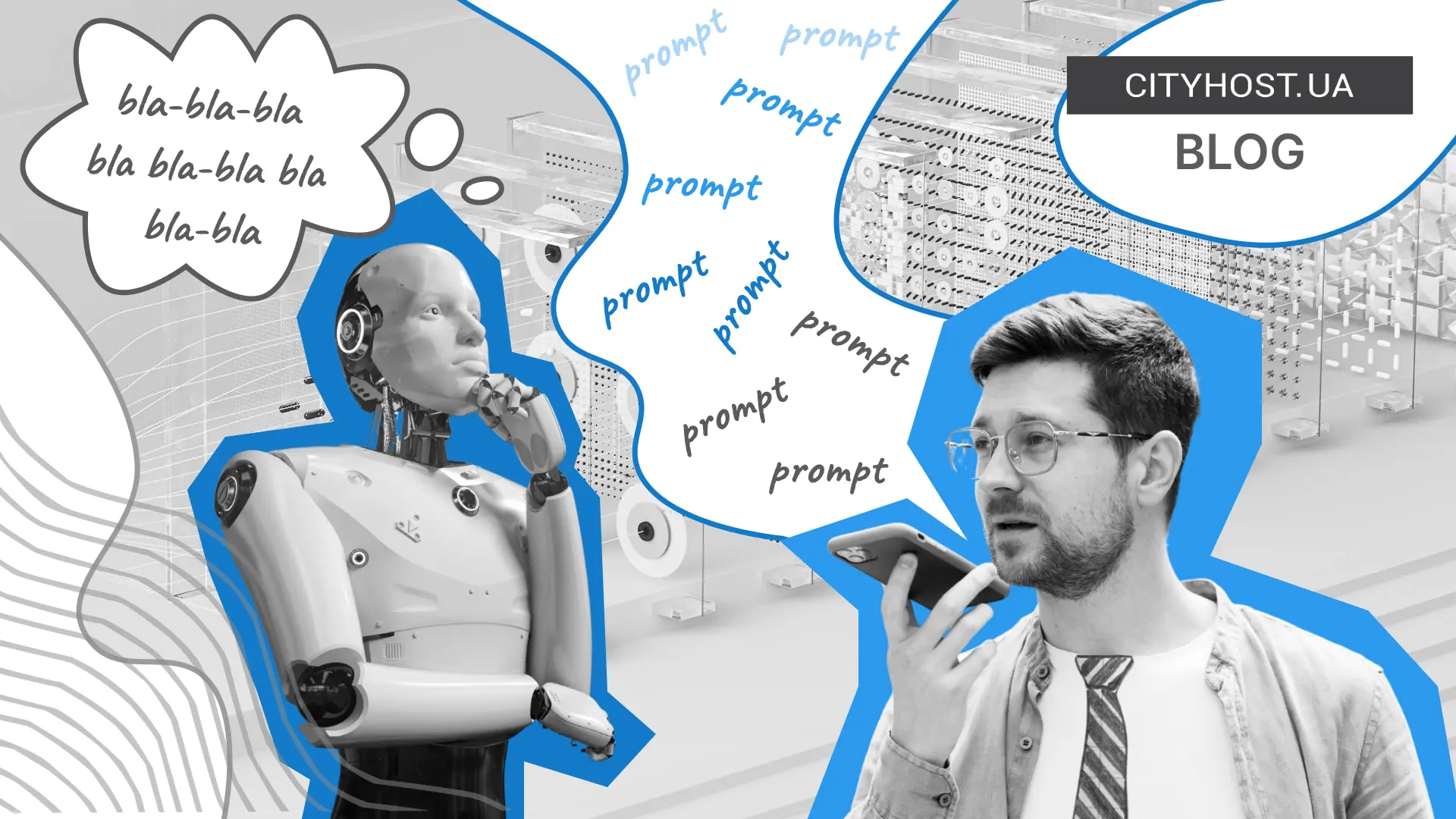
- What is a Prompt and Why is It Important
- What Are the Common Types of Prompts with Examples
- Key Principles of Effective Prompt Engineering
- Prompt Generators for AI — A Way to Simplify Writing Prompts
- Communication with Artificial Intelligence — The Best Way to Get the Desired Result
Using artificial intelligence to solve everyday problems, complete work tasks, and develop skills seems too simple: go to ChatGPT → ask questions → get answers. At the same time, many people complain about the final results: recipes with ingredients they don’t have; articles about a mobile app describing features it doesn’t include; emails filled with unnecessary fluff. And this is not surprising, because most people don’t know how to write prompts for AI, and it is the prompts that fully determine whether you get what you want!
What is a Prompt and Why is It Important
A prompt is a text-based request (question, instruction) that you give to artificial intelligence to get the desired response. This way of “communicating” with AI is similar to addressing another person, and in both cases, the result depends on how clearly you formulate your request.
Imagine you walk into a café and say, “I want coffee.” The barista will then ask: “Americano? Latte? Frappuccino?”, “With milk? What kind?”, “Hot or cold?”, “Small or large?” You’ll not only make the barista nervous but also waste a lot of time yourself. It’s a different story if you clearly say: “I’d like an iced latte with oat milk, no sugar, medium size, with hazelnut syrup.”
The situation is nearly the same with AI services. You can open ChatGPT and say, “I want to make something for dinner”, and you’ll get many questions or just a list of popular options.

Or you can immediately explain what you prefer for dinner and what ingredients you have.
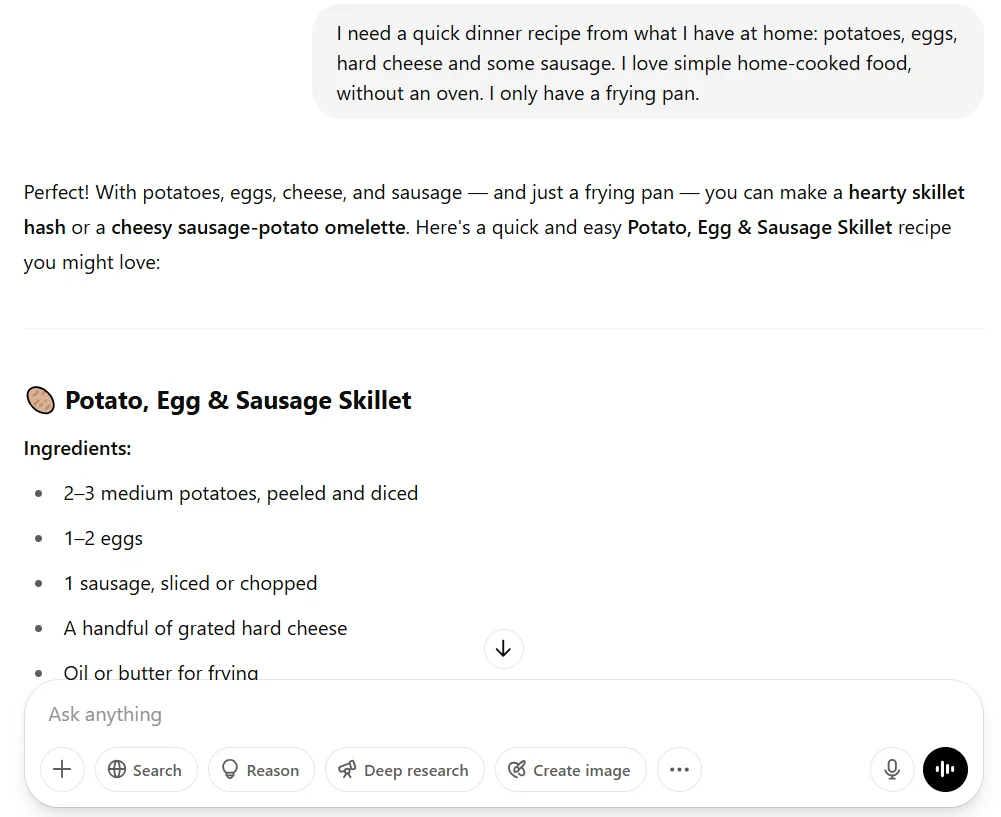
This example of a prompt can be improved, but the main idea is: precise request = precise answer. AI doesn’t read minds; it relies on your words, so the more accurately the prompt is formulated — the more useful the result will be.
And here’s an important point for marketers, copywriters, website owners, and other professionals who are used to working with search engines and using correct search queries. Unlike search engines, which focus on keywords and show pages with matching phrases (we’ve already mentioned how having lots of keywords used to be crucial and almost led to the death of SEO), generative AI services “read” your request as an instruction.
AI services work thanks to natural language processing (NLP) technology: when you enter a text request, the system breaks it into parts — words or fragments — and analyzes the context, grammar, and style to understand your intent. AI doesn’t just “see the words” — it tries to understand the essence of the task and create a response that matches in content and tone. That’s why the formulation of the prompt is critical: it directly affects the quality and relevance of the answer.
Read also: Artificial Intelligence — Friend, Lover, Psychologist
What Are the Common Types of Prompts with Examples
Before diving into the main tips on how to write prompts correctly, it's important to understand the types of prompts for artificial intelligence. Some can help you get a quick answer to a question, others can continue an unfinished idea, and others can perform analysis and comparisons of products, services, or mobile apps.
We have highlighted the most useful types of prompts for AI services:
- Informational. Classic requests that help you quickly get an explanation, definition, or a brief or detailed answer to questions.
“Explain what hosting is in simple terms, for someone who is creating a website for the first time” or “I want to create my own website but don’t understand anything about them. I’ve heard there are CMSs. Tell me briefly what a CMS is and why it's needed.”
- Analytical or comparative. These should be used when you need to understand the difference between concepts, assess pros and cons, or make a decision. It’s important to clearly specify what to compare, the criteria (price, speed, security), and the format of the response (table, list, brief conclusion).
“I’m planning to create a large marketplace for online courses, found a hosting provider, but don’t understand which service to choose. Compare virtual hosting and VPS for a marketplace. Make a table of advantages and disadvantages by criteria: price, scalability, security, ease of administration.”
- Creative. Used for generating ideas, slogans, texts, brand names, and so on. It’s essential to indicate the purpose (what it’s for: website, ad, About Us page), style (humorous, serious, youthful), and limitations (length, language, words to avoid).
“Come up with 5 creative names for a Ukrainian online store that sells farm cheeses from the Carpathians. Target audience — city dwellers who value local products. Style of names — warm, atmospheric, preferably with a hint of Ukrainian identity, no Anglicisms.”
- Step-by-step. Needed to get a clear action plan, step-by-step instructions, or a checklist. These should include the goal, difficulty level (for beginner or advanced), and format (numbered list, paragraphs).
“Describe step-by-step how to create a simple portfolio website on WordPress for a freelancer. Aim for a beginner. Format — numbered list, up to 8 steps.”
- Summarizing. One of the most useful prompt types for AI services, allowing you to shorten a large text or highlight the main points. For example, you’ve found an interesting article but don’t want to spend time reading it, or you need to prepare a report.
“Summarize this text into 3 key points for an internal report. Conclusions should be brief, to the point, and without emotion. Text: [insert text]”
- Role-based. These help the AI “take on a role” — teacher, marketer, lawyer, SEO specialist, etc. Currently, they are especially popular for learning: AI services can develop a learning plan, find materials, check tests. The key is to clearly specify the role and tasks, and describe the audience.
“Imagine you’re a marketer for a Ukrainian online clothing store specializing in modern casual style. Write an SEO-optimized text for the category ‘Men’s Summer Shoes’. The goal is to attract young men aged 25-35. The text should be light, energetic, with a hint of freedom of movement and style. Up to 120 words.”
Each of these prompt types can be used for a wide variety of tasks, and it's not necessary to have access to the best paid AI services. Even the free version of ChatGPT can help with idea generation, drafting, writing texts (blogs, posts, emails), material analysis, learning new things, image creation, and programming. And to perform these tasks, you can combine the above types of prompts for artificial intelligence.
Read also: ChatGPT-4 is available on Bing — How to use artificial intelligence for business for free
Key Principles of Effective Prompt Engineering
You’ve already seen the types and examples of prompts. Each prompt was different, but all of them were based on at least one principle of creating prompts for AI services.
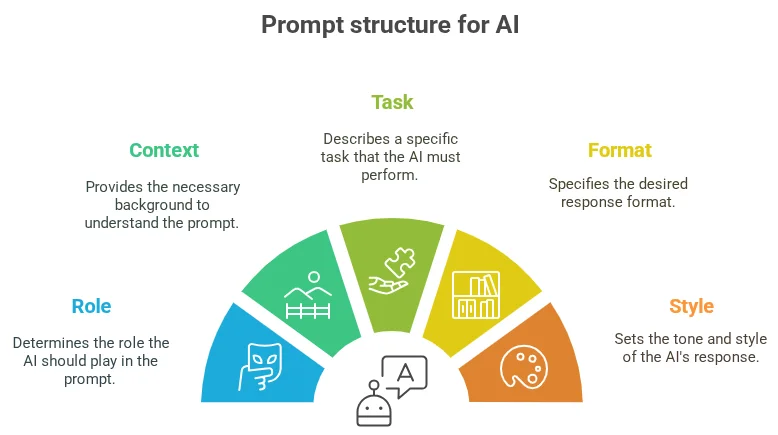
For the best results, it’s better to combine these principles. The more of them you apply in a single request to artificial intelligence, the higher the quality of the result you will receive.
Role — Who Should Perform the Tasks
Artificial intelligence needs to understand who it should be in order to assist you. This helps it choose the appropriate style, depth, and terminology of the response. And one sentence is enough for this:
- “Imagine you are an SMM specialist who focuses on promoting TikTok pages for the English-speaking market.”
- “You’re a brand copywriter who writes texts for small local brands with heart.”
- “Imagine you’re an experienced SEO specialist who works with online electronics stores and understands both external and internal site optimization, category structure specifics, and competitiveness in this field.”
From the very first words (“you are an SMM specialist”, “UX designer”, “SEO expert”), artificial intelligence determines its scope of responsibilities and can apply them to provide qualified assistance.
Context — the Knowledge Required to Complete the Task
Now you need to clearly explain to the artificial intelligence who you are and why you need to complete the task. Without context, AI services won’t respond accurately — they’ll just make up information.
Here are a few examples of context in AI prompts:
- “I’ve been doing copywriting for over 5 years. I created a TikTok channel 3 months ago to find new clients. Right now it has 20 videos and 500 followers. Recent videos only get 200-300 views, although before they had 3000–5000, and there are no new followers or orders at all.”
- “I make soy wax candles at home in Lviv. My brand is called ‘Fire’, we sell through Instagram and are now launching a website. I want the ‘About Us’ section to convey warmth but not sound pretentious — no ‘unique scents’ or ‘inspired by nature’ like our competitors.”
- “We have an online electronics store operating across Ukraine. The product range is large: laptops, smartphones, networking equipment, accessories. The website is on OpenCart CMS, it's 3 years old. Basic settings are in place, some pages are being promoted, but traffic remains steady — 300 organic visits per day. The main goal is to reach the TOP for our categories and increase traffic 5-10 times over the next six months.”
In the examples, the information is presented as concisely as possible. The main goal is to clearly describe your business without overloading the AI with data.
Task — Specific Work for AI
Now, clearly explain to the AI what exactly it should do. You need to be both specific with your instructions and concise, or else the AI might get confused.
Let’s continue looking at our prompt examples, but now we’ll focus on formulating specific tasks:
- “Analyze why the views are so low and there are no new subscribers. Suggest a strategy with 5 new video ideas that have a chance to resonate with my audience.”
- “Write 2 versions of a short text for the 'About Us' page to engage new customers and build trust in the brand.”
- “Analyze the situation and propose an overall 6-month SEO strategy: where to start, what to focus on, and what tasks are critical for growth.”
Important! We are providing general examples of context and tasks. In your prompt, you should include information specific to your business, such as more detailed data about the company, an analysis of a social media account, Google Analytics reports, and so on.
Format — What the Result Should Look Like
AI services don’t know how you want your answer to be presented. People often complain that ChatGPT uses too much bold text, writes very short first paragraphs, or presents information only in list form. But the real mistake lies with the users — they assume the system will read their minds.
Let’s look at prompt formats for artificial intelligence based on the previous examples:
- “Give a list with short video titles, format (talking head, text on screen, etc.), optimal duration, key message, and example hashtags.”
- “Each option — up to 100 words. Paragraphs allowed. One should be more emotional, the other with a touch of humor.”
- “Structured list of stages (by month), each with a brief description of tasks: technical SEO, content, link building, and so on. If you need clarification, specify what data you require.”
The format saves your time and immediately delivers the desired result format.
Style and Tone — How It Should Sound
The same text can be boring or engaging — it all depends on the tone. And this isn’t just about AI-generated copywriting or writing in general, but about how the information is presented to you. Maybe you absorb data better in list form, as plain text, or a mixed format — artificial intelligence can generate results without prompts, but there’s no guarantee they’ll match your preferences.
For better understanding, let’s look at some examples:
- “The answer should be concise, without fluff, with tips I can test right away. You can address me directly, like a marketer talking to another marketer.”
- “English language, simple, warm, slightly conversational. No clichés. As if I’m telling the story myself on Instagram Stories.”
- “The answer should sound like it’s from a colleague: clear and to the point. No explanations of basic things (like SEO is search engine optimization). Write in Ukrainian, simply and clearly, as if you’re explaining to a teammate.”
AI adapts well to tone — if you clearly specify it.
Prompt Generators for AI — A Way to Simplify Writing Prompts
We’ve already provided formulas and examples that can be used as templates. However, sometimes you just want to significantly speed up the process.
That’s why we’ve compiled a list of the best free prompt generators for artificial intelligence, which will help you get the best answers from ChatGPT, Gemini, Midjourney, and other AI tools:
- AIPRM for ChatGPT. A free Chrome extension that offers many prompt templates for ChatGPT. At the time of writing, the extension had 5319 prompts, categorized into groups (SEO, copywriting, marketing, productivity, and others). You can save your favorite templates for quick access and even create your own versions. Keep in mind that AIPRM integrates with ChatGPT, so the response time may slightly lag.
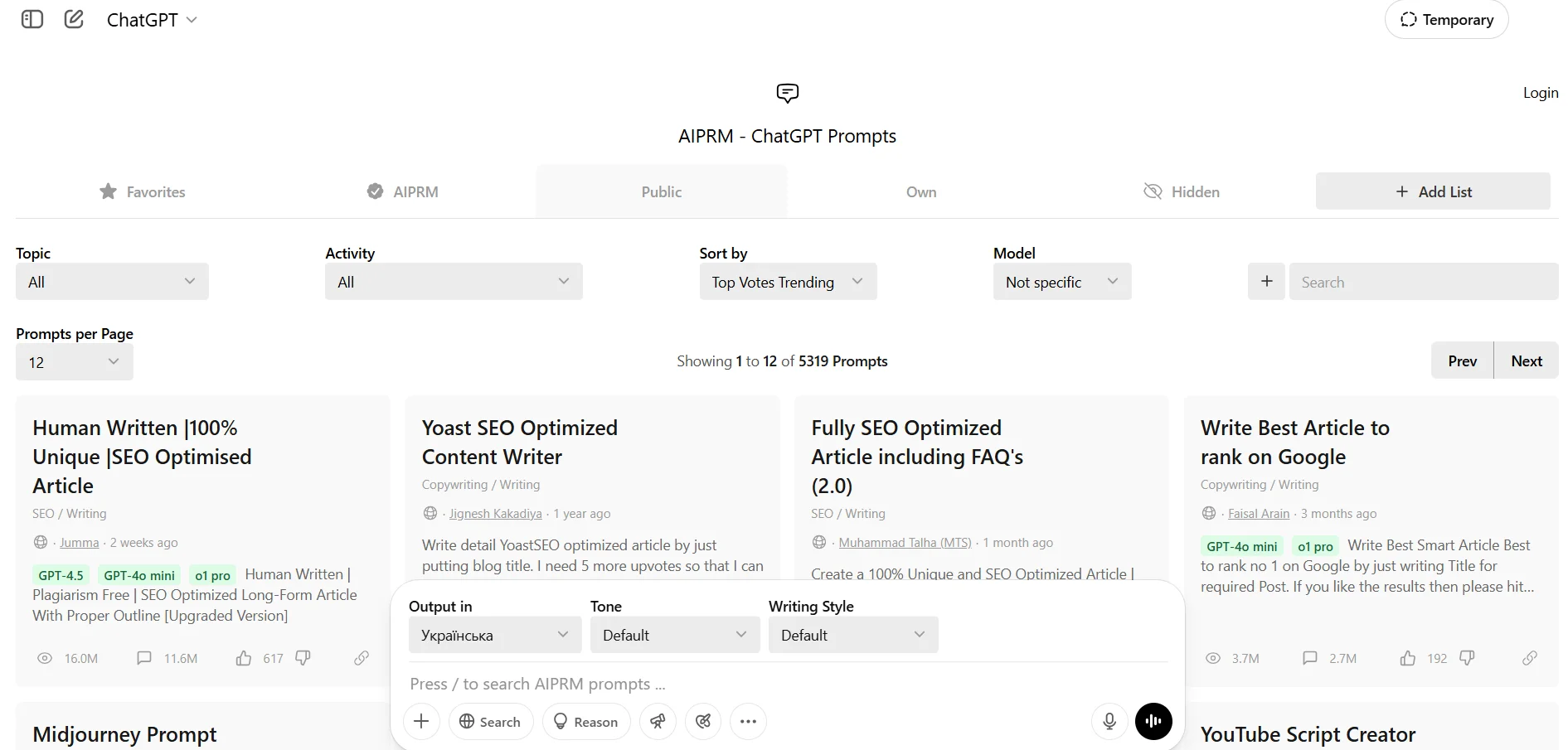
- Moxby. Prompts for AI services are divided into categories: advertising, business, art, design, education, and others. You select a category, find the appropriate prompt, and click "View Prompt".

On the page, you’ll find a description and the option to copy the prompt.

- PromptHero. A free platform with thousands of prompt templates. It's perfect for image creation. You simply visit the website, register, and choose an image.

On the image page, you can view the parameters and copy the prompt.

- Easy-Peasy.AI. A service for quickly generating queries for ChatGPT and other AI models. It provides 2 free prompts per day. You go to the site, enter the main idea, and choose the language.
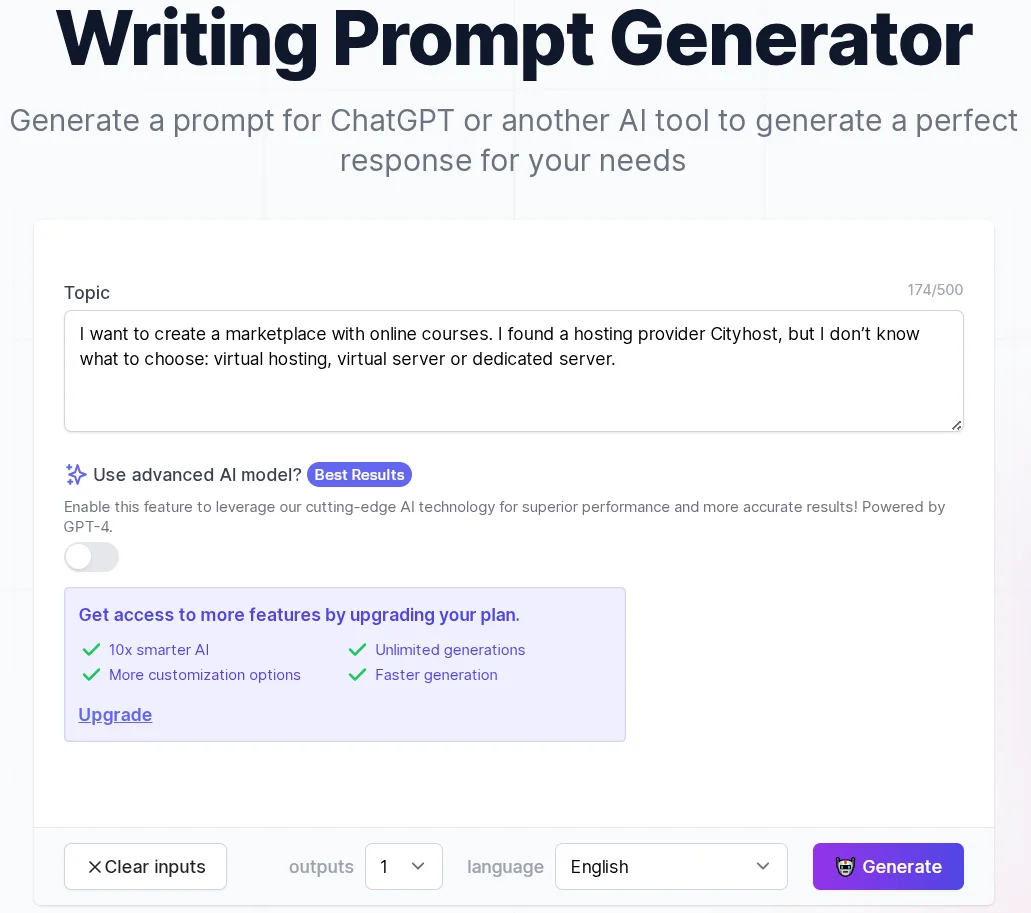
Then click "Generate" and receive a clear AI prompt.
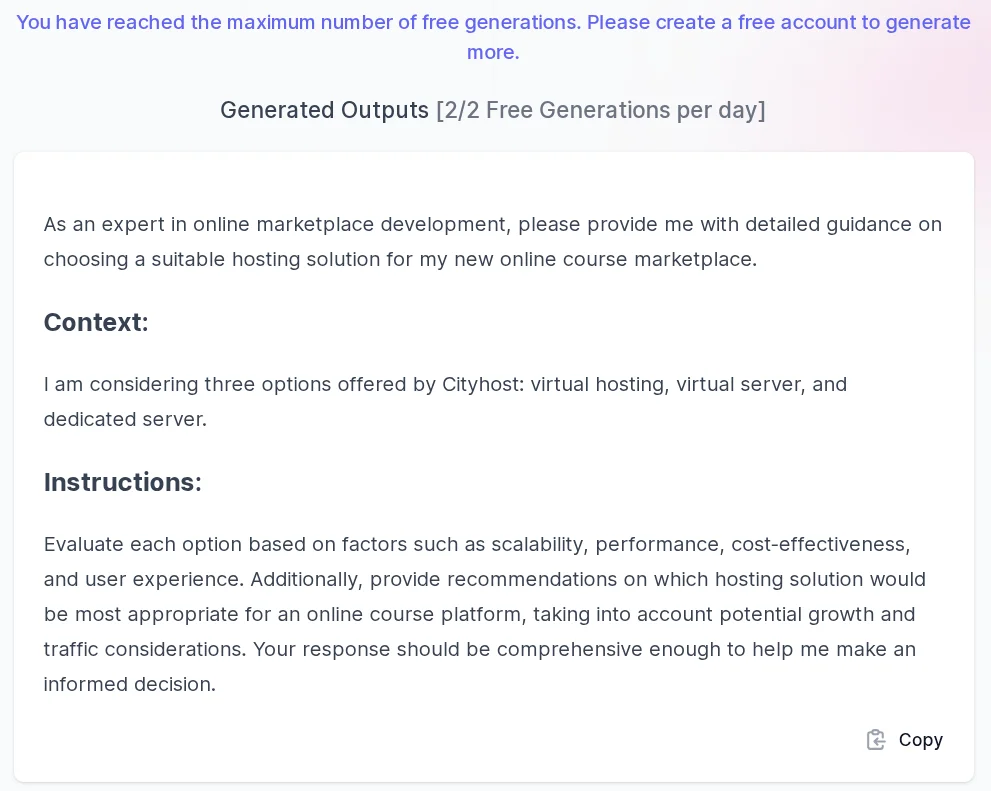
Most AI prompt generation services do not support Ukrainian. However, you can find a template and translate it, or, since generative models were primarily trained on English-language content, you may get a more accurate result in English and then translate it into Ukrainian. Just remember to adapt it to your needs.
Read also: TOP-5 online chats for the site: Gerabot, LiveChat, HelpCrunch, Tawk.to, KwizBot
Communication with Artificial Intelligence — The Best Way to Get the Desired Result
Artificial intelligence has developed to the point that a separate profession has emerged for effective interaction with it — Prompt Engineer. However, even if you don’t plan to work professionally in this field, basic skills in creating prompts will help you solve everyday problems more efficiently, learn faster, and work better. After all, a well-formulated query increases your chances of getting a high-quality response. On the other hand, a too-general or vague instruction can lead to an undesirable result.
Just don’t forget to communicate with artificial intelligence. Consider it your assistant, which also needs clarifications and questions. Don’t be afraid to check the answers you get, clarify instructions, rewrite or detail your queries. If the result doesn’t satisfy you, try asking a direct question: “What else do you need to know to give a better answer?” This will help create a truly productive dialogue with the system and get the desired result without unnecessary stress or wasting an excessive amount of time.










